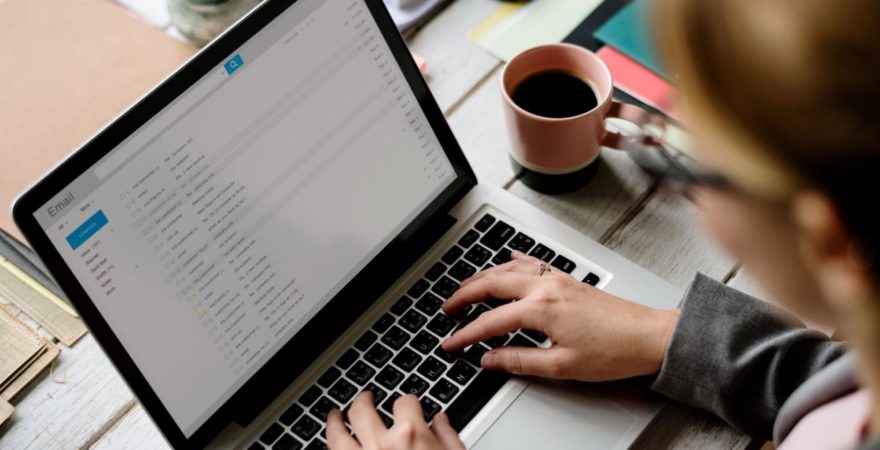Are you wondering how to write a professional email? Stress not, because we’ve compiled a comprehensive guide that’ll certainly help you to write a professional email.
Well, it may look like writing a professional email is not a big deal, and anybody can write, but unfortunately, it isn’t true. You can write an effective email only if you understand the certain element that helps you attract the reader’s attention.
You see, people’s inboxes are flooded with uncountable emails but not each one of them is read (For an apt example- you can see your email right now and the list of unread messages). Hence, first thing first, think of what you’re writing in that specific email and to whom you’re writing. Is it for job application, proposal mail, or to a client? Each one of them has to be written distinctly and concisely in a professional manner. It should be organized enough to make it look like a professional one.
Emails perhaps are not the only thread of business communication, but it is still a basic ethic that shows your professionalism and builds a certain standard for you. No matter which domain, the field you belong to, emails are always the first source to start your interaction on the professional front. It plays a prominent role in business process management, managing your employees, customers, and everything in between. Hence, it is one of the pioneer components in today’s workplace.
When it comes to writing for a job application, you need to compose it straightforwardly in a well-mannered way. Like any other communication method, consider saying your story after greeting them well. Convey your message and ask the recipient to revert you.
So, in this guide, we’ll discuss how to greet, how to conclude your draft, what else you can follow, and what mistakes you should avoid while writing an aced email.
So without any further ado, let’s get started with:
The Rules of Writing a Well-Organized Email

1. Firstly, Decide
Before you proceed with writing the email, think first. Make it certain that your email can adversely affect your individuality or your company. Therefore, understand to whom you’re writing the email. If you’re writing for a busy person, make sure to keep it short and simple. If you write a lengthy one, the latter can get annoyed and might simply avoid reading it.
Remember your draft should be composed of the recipient’s nature. Having a clear mind on what type of email you’ve to write will help you a lot.
2. The Purpose
It is very crucial to be clear on your purpose. If your goal is hazy, you may end up writing an absurd email. Hence, ensure what’s the purpose of your email and also what’s the best time to send the mail. If you’re clear with your purpose, you’ll express yourself effectively and interestingly.
If you’re unable to find out your goal, it will be a waste of time for you as well as for your target audience.
3. Create Meaningful Subject Line
Based on your purpose, create a concrete subject line so that your recipient can have an idea of what you’re going to tell inside. The subject line is the teaser of your story, and unfortunately, many people ignore this aspect recklessly. It’s the subject line that grabs the recipient’s attention and as mentioned above, remember the recipient receives hundreds of emails daily, so how do you stand out among those emails? You know that already.
An email with no subject line or without a proper subject line can get your email into the trash bin. Therefore ensure to provide a concise subject line. For instance, if you’re applying for a job, make sure to provide your name and the job role you’re applying for and vice versa. Upon this, don’t create a subject line that makes you sound desperate- using words like Urgent, Hurry-up, Please, etc.
4. Decide the Format
Herein, by format, we mean compose your email according to the bond you share with your recipient. If you’re sending an email to a professional client, make sure to draft your message in a formal and professional tone. Whereas, if you’re sending the email to a known and casual person, you can use informal language to share your message.
5. Keep Your Email Short & Simple
Unless it is absolutely necessary, always adhere to creating short, simple, and to the point emails. Today, the world is super busy, and people have a lot of other commitments to do. In this hectic time, they won’t prefer reading your lengthy essays like emails.
Therefore, create short and simple language emails that are readable and understandable to the recipient.
Do not keep them beat around the bushes by reading your complex and guessing what message. Instead, communicate with them in a way like you’re doing a conversation sitting at a table and sipping a cup of tea with your friends.
6. Greet Well
Whether you’re drafting a short or a long email, always start with a greeting. It is a good sign of email etiquette to greet the person you are writing to. Note that it mostly depends on how formal or informal the person you are writing to. Thus, try keeping your greeting formal always when writing a professional email.
If you are writing to a known person, you can begin with “Dear Mr. Mosby,” “Dear Michael,” or “Hi, Robin.”
But, if you are writing to an organization, you will need to research it to get to know the person managing the emails and avoid using the term like “Whom it may concern” statement.
Another way you can choose to greet the recipient is by using a line like “Dear Hiring Manager” and so.
7. Introduce Yourself
After greeting the respective person, you need to introduce yourself straight away, notably if it’s your first time contacting them. Try to brief yourself, preferably in one or two lines. For example: “Hi, I am Quinn. I work as a content writer, and I’ve accomplished various SEO and other emerging formats projects. Kindly have a look at my portfolio below ____.”
Introducing yourself is a great gesture. Perhaps, many people believe mentioning your name in the introduction is repeating as the same name will appear in the email address, but that’s not true. If you mention your name in the introductory line, it makes them understand who you are. However, if the person knows you, you can skip using your name.
8. Sign-off Your Email Professionally
Sign-in-off doesn’t mean just to thank the recipient before that; close your remarks and let them give an idea of what they have to do next. It’s a good opportunity to nudge their actions. For example, close stating things such as “I’m looking forward to meeting you soon,” “Waiting for you to share your thoughts on the project,” and so on.
Also, make sure to thank your recipient in the same draft by saying “Thank You for reviewing my application” or “Thank You for reading my proposal,” After this, conclude your mail by mentioning your name like:
- Thanks & Regards
- Warm Regards
- Thankfully
- Sincerely
- Best Regards
- Respectfully
- Kind Regards
You can also end it casually depending on whom you are writing for, and this can be simply:
- Thanks
- Cheers
- Best
Apart from the above pointers, consider some more aspects like checking on your grammar, punctuation, alignment, and also note not to lose the essence of your mail in a mid-way. Make sure it makes sense right from the top to bottom to the subject line and closing.
Now that you’ve learned the basic elements of writing an email, ensure to follow the below enlisted professional rules before clicking the send button.
Additional Tips to Write a Professional Email
#Tip1
Show Empathy
Before sending your email, preview and read it twice to ensure that the message truly speaks to what you want to convey. Read the email from the recipient’s point of view and ask yourself:
- Are you able to understand the sentence and the whole message?
- Does it make any sense?
- How would you feel to receive such a message?
#Tip2
Write carefully
Your email is just a reflection of who you are. Hence, make sure to create in a way that leaves a good impression on your recipient. For instance, if you write a disorganized email full of errors and spelling mistakes. In that case, your recipient may consider you as a careless person. Remember, an email can either build or break your reputation; it simply depends on how expertly you write to your recipients.
#Tip3
Make Sure Your Email is Complete
Sometimes, a person forgets to write the subject line, add a signature, or attach the required file in a hurry. Thus, before hitting the send button, ensure your email is incorporated with these factors; keep the respective person on loops in CC and BCC besides sending it to the authorized person.
#Tip4
Proofread Your Email
From contact id to subject line, body, and the closing remark. Do not commit the mistake of not proofreading it. Note that overconfidence can make you look clumsy, so it’s better to read it properly before sending it to the recipient.
#Tip5
Include Your Contact
Your recipient may try to reach you through either of the ways. Thus, make sure to include your contact number, website link, attach your social media profile- preferably LinkedIn’s profile, and so on so that they can reach you according to their preferences.
Things to avoid While Crafting an Email
- Avoid using complex and flowery vocabulary: Recipients may find it annoying to see highly complicated words and unnecessary adjectives and designer words. Rather, opt to write in simple language using common words so that anybody can read easily and understand.
- Compose the draft in a professional font: Keep your fonts professional and formal, like words and language. Do not try to design and focus on it aesthetically; focus only on your message.
- Avoid writing sales emails: Don’t make your email sound like an advertisement. Instead of creating salesy email, try creating informative and meaningful emails that truly entices your audience.
- Don’t skip to attach a file: People often forget to attach the file they talked about in their email. This looks totally drab to your recipient. Therefore, ensure you’re attaching the required file and documents.
- Don’t attach bulky files: Most of the time, people attach a huge file and take a lot of time to download. People are busy, and only a few have the patience to wait until a huge file is downloaded to read what is inside. People may simply ignore finding that it requires time and bundles to download the file. Therefore, ensure to check the size of the file you are supposed to send; if it’s huge, try to compress it.
- Avoid writing too casual: An aced email should be written in a formal manner. At least do not write in a too-casual tone. You must keep away from those absolutely lowercase letters or text languages like- Lol, U, thx, Wassup, and many others. Spell every word in full and avoid using shortcuts and abbreviations.
- Do not add too many contacts: It is necessary to add your contact. However, make sure not to add too many irrelevant contacts like your Instagram or Tiktok ID. Attach only which is professionally good.
- Do not use phrases like “To whomsoever, it may concern”: This is surely a blunder mistake that you must ensure to avoid at any cost. Today, companies have added their information on the internet. So make sure to do enough research and find out the authorized person. Using “To Whom it may concern” signifies that you haven’t bothered yourself to research before writing the email. If you’re unable to find a name to address to, you better denote the person by their title, such as “Dear hiring manager” or “To the Head of the HR Department.”
Final Thoughts on This
So this was a complete directory on how to create a professional email. With this guide and the etiquettes mentioned inside, you can totally nail the art of creating a compelling email that creates a splendid impression of yours on the recipients.
References: The muse, Indeed








